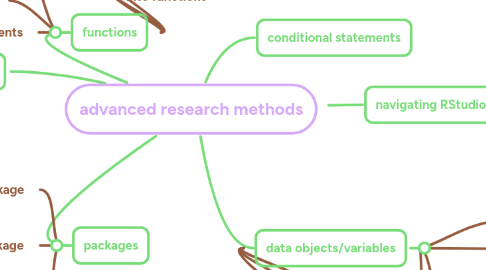
1. data objects/variables
1.1. created using "<-" operator
1.2. container storing information
1.2.1. to contain text, use inverted commas
1.3. stored in environment
1.4. vector
1.4.1. list of numbers
1.4.1.1. can define sequence using colon
1.4.1.2. can define sequence by combining values via "c"/concatenate operation
1.4.1.2.1. compatible with non-contigous enteries
1.4.2. index specific values using square brackets after vector name
1.4.3. index range of values by using colon
1.5. can be used as indicies
1.6. can have multiple dimensions
1.6.1. matrix
1.6.1.1. two-dimensional data, e.g., rows and columns
1.6.1.2. have to input size of matrix
1.6.1.3. can index all columns for specific row and request range of values using colon
1.7. data frames
1.7.1. combines objects/vectors into single object
2. navigating RStudio
2.1. console
2.1.1. located in bottom left
2.1.2. insert commands to be executed immediately
2.1.3. all code executed is echoed to console with outputs
2.2. script
2.2.1. located in top left
2.2.2. text file containing code
2.2.2.1. individual chunks of code ran via highlighting
2.2.3. can be saved and shared
2.2.4. strengths
2.2.4.1. record of analysis for future reference
2.2.4.2. peer checking of errors and possibility of reproduction
2.2.5. created via "Files" menu
2.3. environment
2.3.1. summary of all information in R's memory
2.3.2. history tab
2.3.2.1. tracks all commands executed within session
2.3.3. can be saved to files
2.3.4. located in top right
2.4. other
2.4.1. files
2.4.1.1. file browser, e.g., open scripts and data
2.4.2. plots
2.4.2.1. displays and exports created graphs
2.4.3. packages
2.4.3.1. list of installed packages
2.4.4. help
2.4.4.1. help files
2.4.5. located in bottom right
3. conditional statements
4. functions
4.1. section of code wrapped up, accepting more than one input and producing more than one output
4.2. appear in environments
4.3. considered a type of object
4.4. can pass values from data objects into functions
4.5. "return" function
4.5.1. tells R to pass output object out of function so available in environment
4.6. can define new functions
5. packages
5.1. "Shiny" package
5.1.1. dynamic interfaces to R code that can run in web browsers
5.2. "RMarkdown" package
5.2.1. documents combining text, computer code and figures
5.3. "Tidyverse" tools
5.3.1. uniform approach to organising and manipulating data
6. introduction to R
6.1. primarily interpreted language
6.2. can run programs directly instead of translating to machine code first
6.3. strengths
6.3.1. manipulation
6.3.2. analysis
6.3.3. visualisation of data of various kinds
